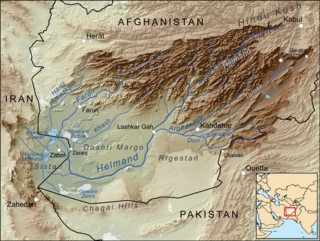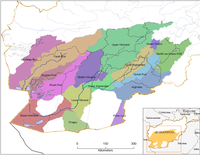
Sistan and Baluchestan province is the second largest province of the 31 provinces of Iran, after Kerman province, with an area of 180,726 km2. It is in the southeast of the country, bordering Pakistan and Afghanistan, and its capital is the city of Zahedan.

The districts of Afghanistan, known as wuleswali, are secondary-level administrative units, one level below provinces. The Afghan government issued its first district map in 1973. It recognized 325 districts, counting wuleswalis (districts), alaqadaries (sub-districts), and markaz-e-wulaiyat. In the ensuing years, additional districts have been added through splits, and some eliminated through merges. In June 2005, the Afghan government issued a map of 398 districts. It was widely adopted by many information management systems, though usually with the addition of Sharak-e-Hayratan for 399 districts in total. It remains the de facto standard as of late 2018, despite a string of government announcements of the creation of new districts.

Khash District is one of the 28 districts of Badakhshan Province, Afghanistan. It was created in 2005 from part of Jurm District and is home to approximately 43,306 residents, making it the third most populous district of the province.

Khash Rod District or Khashrowd, Balochi: خواشرود)is a district of Nimruz Province in Afghanistan. It had a population of 35,381 in 2004, which was 55% ethnic Pashtun, 20% Baloch, 15% Brahui and 10% Tajik. The district capital is Ghorghori.

Dasht-e Margo, also Dasht-e Mārgow or Dasht-e Margoh, is a desert region in the southern provinces of Nimruz and Helmand in Afghanistan. The desert is adjacent to the Dasht-e Khash and Registan Desert. It is the world's 20th largest desert at about 150,000 km2 in area with an elevation of 500–700 m. The desert consists mainly of sand masses and rocky-clayish plains with solonchaks, takirs, and rarely oases.

Khash is a city in, and the capital of, the Central District of Khash County, Sistan and Baluchestan province, Iran, and also serves as capital of the county.
Khash Darreh is the name of two villages in Badakhshan Province in north-eastern Afghanistan.

The Kokcha River is located in northeastern Afghanistan. A tributary of the Panj river, it flows through Badakhshan Province in the Hindu Kush. It is named after the Koksha Valley. The city of Feyzabad lies along the Kokcha. Near the village of Artin Jelow there is a bridge over the river.

Delārām is a city in the northern part of Nimruz Province, in southern Afghanistan. It is a major transportation center, with several major road converging on the area, including Kandahar–Herat Highway, Route 515 to Farah, Route 522 to Gulistan and Route 606 to Iran. The district center contains a large bazaar.

Route 606, also known as Delaram-Zaranj Highway, also officially designated as NH49, is a 218 km roadway in the Nimruz Province of Afghanistan connecting the Delaram District in Afghanistan to the border of Iran. The opposite way goes towards the south near Zaranj, Afghanistan. It is one of the busiest roads in Afghanistan and provides an important trade route between Iran and the rest of Asia. It was developed by India's Border Roads Organisation.
The Dasht-e Khash, also Dasht-e Khash or Dasht-e Khāsh. is a desert in Afghanistan's Nimruz Province. The desert is adjacent to the Dasht-e Margo. It is located at 620 m above sea level.
Ghorghori city, also called Ghurghuri is a town and capital of Khash Rod District of Nimruz Province, Afghanistan.
In June 2020, insurgents and the Taliban carried out attacks throughout Afghanistan in a continuation of attacks carried out in May.

The Registan–North Pakistan sandy desert ecoregion covers the dry Sistan Basin of southern Afghanistan and portions of eastern Iran and southwest Pakistan. The Registan Desert is the eastern portion of the Sistan Basin. The region is almost entirely dry sandy desert, with some irrigated cropland along the rivers. There are some seasonal wetlands at the western terminus of the Helmand River into Hamun Lake. The region support five endemic species of reptiles.

The capture of Zaranj, the capital of Nimruz Province, Afghanistan, occurred on 6 August 2021. According to the local officials, only the National Directorate of Security (NDS) and its forces had put up a fight against the Taliban, but they too eventually surrendered to the Taliban. Local officials had been requesting for reinforcements but received no response. Zaranj was the first provincial capital to be taken by the Taliban in their 2021 offensive and the first one to be captured since Kunduz in 2016.
Khunia, is a village in Khash Rod district of Nimroz Province, in western Afghanistan and close to Qala-e Nawa and Mazad villages. This village is located on the same latitude as Khash. It lies on the right bank of the Khash River, which is three miles distant. Per Tate information in 1904 year, this village was the residence of Badin Khan, Nurzai, and there were number 52 families inhabitants. And in this year (1904) the lands had afford employment of 8 Ghani, and 2 Tahwil Pagos & Irrigation was done by flood water canals.
Shishāwa, Sheshāba is a village in Khash Rod district of Nimroz Province, in western Afghanistan. This village located on the right bank of the Khash Rud River and about 8 miles west of Khash village. Per G.P. Tate information in 1904 year, this village was the residence of Akbar Khan, Baluch, Uzbakzai tribes, and in that time there were number of There are 110 families forming 12 ghani pagos. Also, it is said, there was enough waste land near the village to find work for 40 pagos.












